Introduction: Problem Background
The number of PLDs is getting increasingly large. Although the modern nursing strategies are aimed at addressing the related PLD issues, they often fail to meet the needs of the target audience.
- LD make the most common mental issue among the contemporary US population;
- LD is especially topical in children and young learners.
Learning Disabilities (LD) remain one of the topical issues on the modern nursing agenda (Cortiella, 2014). The number of patients with learning disabilities (PLDs) is growing consistently, as the recent data suggests (World Health Organization, 2012). According to the latest information provided by NCLD (World Health Organization, 2014), 42% of special education students suffer from LD and, therefore, need the corresponding assistance from qualified personnel (Burton, Kagan, & Clemens, 2013).
Therefore, there is a strong need to create the framework that will lead to the improvement in the outcomes of the nursing services provided to the target population. It is crucial that the corresponding strategies should be efficient and that the therapies should be carried out in a timely manner. The adoption of the patient-centered approach is strongly recommended to meet the needs of the target members of the population.
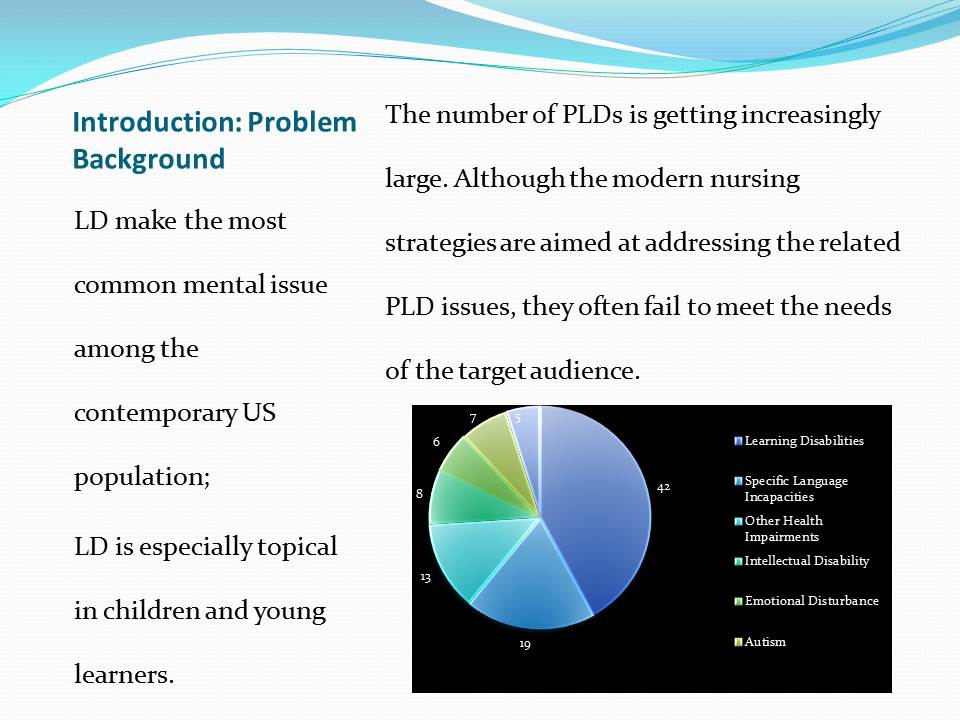
Introduction: Problem and Purpose
Since the idea of PLDs having unique abilities and talents is usually dismissed by nurses, a range of opportunities for PLDs to explore their learning options are lost;
Focusing on the promotion of communication between PLDs and the rest of the community members can be viewed as the means of enhancing the patients’ communication skills acquisition;
By stressing the talents that PLDs display in the curse of the communication process, one is likely to encourage the patients to be even more active in their learning process.
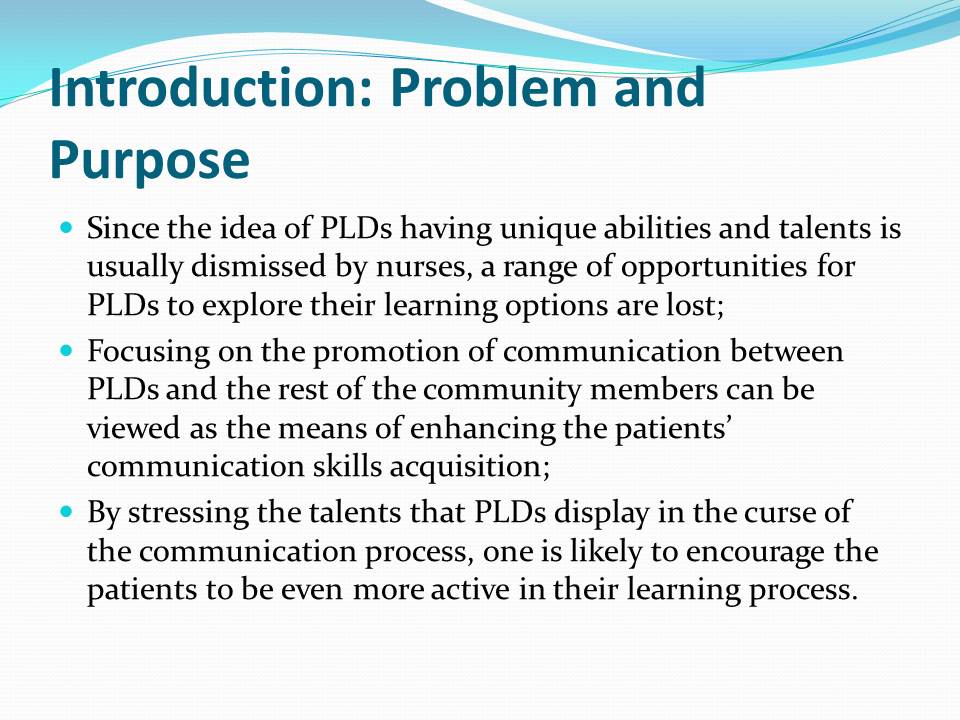
Theoretical Framework: Concepts that the Study Is Based on
- The current theories of disability tend not to place the emphasis on the importance of addressing the patients’ need to locate their unique abilities and talents;
- The Social Model of Disability, on the contrary, points to the fact that the society determines the attitude towards the idea of PLDs having unique talents;
- The Social Model helps explore the influence that the social prejudices has on the current nursing approaches toward meeting PLDs’ needs;
- The Social Model of Disability may be used as the tool in improving the current approach toward managing the PLDs’ therapy and intervention processes.
The Social Model of Disability is considered the primary tool for designing the framework that the analysis will be based on. The reasons for considering the model mentioned above is rather basic. In contrast to the rest of the theories, the model stresses the significance of the social factors that inhibit the mental development of PLDs. As a result, the issue of disregarding the possibility of a PLD having a talent can be raised. More importantly, the model provides premises for designing the tool that can be used to seek, identify, and work on the unique talent or ability of a PLD.
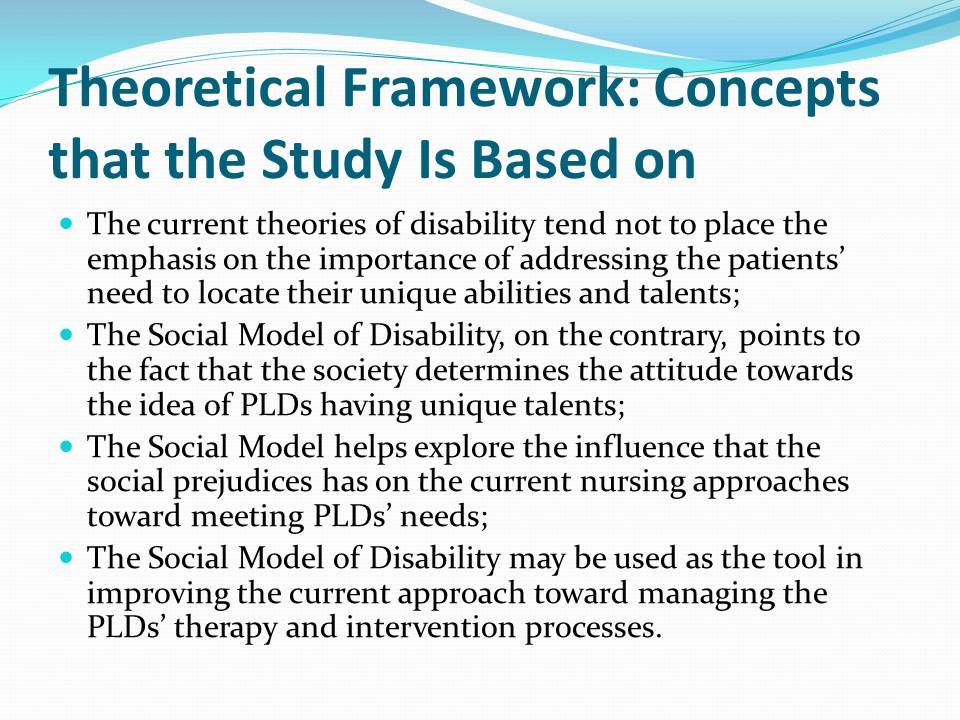
Research Question and Hypothesis
Question
Does the emphasis on the patients’ unique talents and abilities, as well as the use of crossed networks, in which PLDs will communicate with the rest of the community members, help improve the patients’ learning progress and promote a faster acquisition of the corresponding skills?
Hypothesis
The use of the crossed networks, in which online communication between PLDs and the volunteers from the community will be promoted and supervised by the nursing staff, and the application of the talent-oriented therapy aimed at detecting unique abilities of patients and encouraging their development is in a direct correlation with the patients’ success in mastering the corresponding learning skills.
The current study aims at proving that there is a direct correlation between the use of the crossed networks as a communication platform, the application of the talent-oriented approach, and PLDs’ ability to acquire the corresponding learning skills. It would be wrong to claim that the usage of the specified tools will have an immediate and absolutely positive effect on all PLDs. However, it is believed that the adoption of the tools in question will ultimately lead to a gradual growth of PLDs’ motivation in the learning process and, ultimately, their progress.
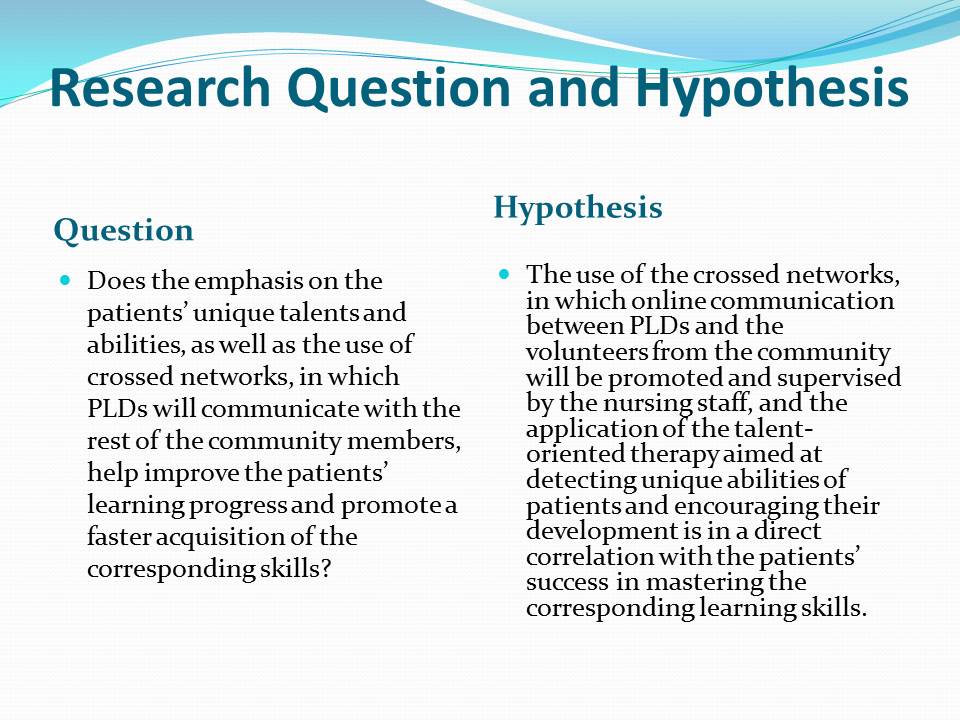
Variables and Operational Definitions
Variables
- Dependent variable: PLDs’ abilities (intellectual and communicational);
- Independent variables: talent-oriented therapy; crossed network for communication with the community members;
- Extraneous variables: PLDs’ enthusiasm and engagement rates;
- Means of controlling extraneous variables: providing rewards, appraisals, and emotional support to the PLDs involved in the case study.
Operational Definition
The number and the percentage of errors made by the participants in the course of the communication process, as well as the times that they use their unique talents in the communication process, will be the primary measure. Thus, the quantification of the progress that the people involved in the study will make can be carried out.
Three primary variables will be considered in the course of research. The changes in PLDs’ learning abilities and progress will be the key dependent variable. The participation in the crossed network environment (i.e., communication with the rest of the community members via online platform) is the independent variable of the secondary importance, whereas the one of the primary significance is the application of the talent-oriented nursing and the focus on the unique abilities of the patients.
The overall motivation and enthusiasm rates among the target members of the population, in their turn, will have to be viewed as the primary extraneous variables. Although certain tools for controlling them will be designed, the identified variables are outside of the researcher’s reach. Rewards and appraisals will be used to take the identified extraneous variables under control.

Sample and Setting
Sample
- 200 participants will be selected to be included in the experiment;
- The PLDs taking part in the experiment will be chosen based on the principle of convenience sampling;
- The local nursing facility will be used as the area for selecting the research participants;
- The sample was calculated with the help of a specific formula is used as the means of calculating the sample for a paired t-test;
- According to the formula and the related calculations, the sample will make 102 people.
Setting
- The local nursing facility will be the setting for the case study;
- The absence of outside factors that may affect the test results is the reason for choosing the setting.
A nursing facility located in the vicinity will be used as the setting for the case study and the selection of the research participants. Informed consent letters will be distributed to the legal guardians of the PLDs in the identified nursing facility. Afterward, 200 people will be selected to participate. By using the formula for a quantitative study suggested by Randolph and Myers (2013), one will be able to determine the required sample size. The sample size will make 102 people in the case in point (Randolph & Myers, 2013).
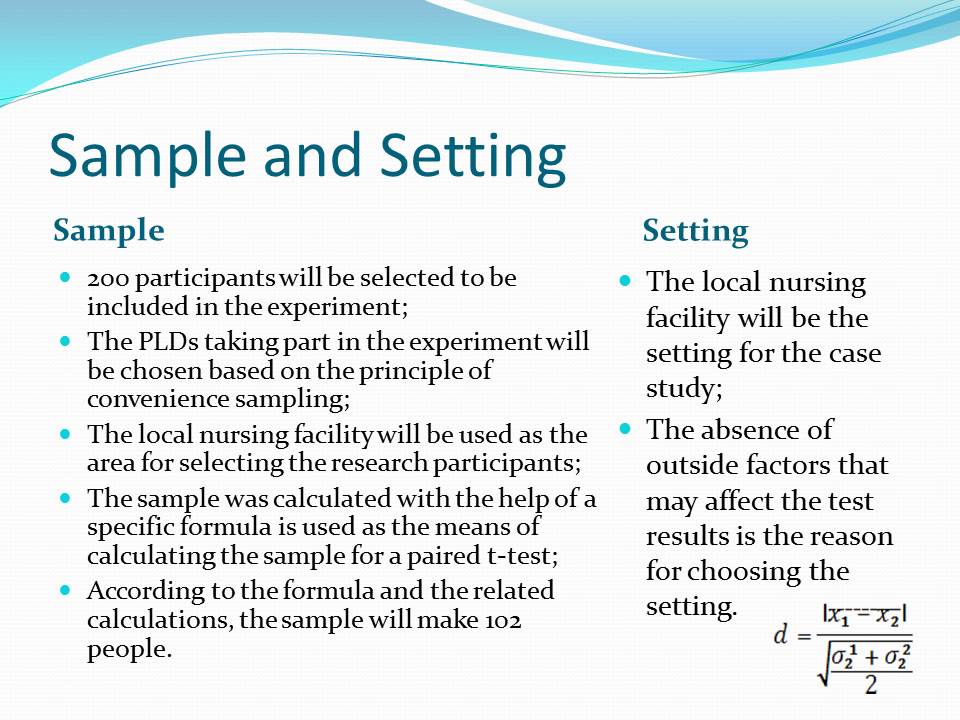
Design
Case Study Pros:
- Helps embrace a vast range of data;
- Provides opportunities for considering the problem in great detail;
- Helps adapt ideas so that they could be tested successfully.
Case Study Cons:
- Lack of opportunities for outcomes generalization;
- Issues with identifying the cause-and-effect relationships.
The case study was chosen as the research design. The reasons for selecting the specified type of research are quite obvious; a case study will help embrace a significant amount of information and collect the data from a large number of participants, at the same time retaining the credibility of the outcomes.
Furthermore, the case study serves as an efficient tool for analyzing the manner of and the extent to which the participants’ behavior alters in the course of the study. Thus, the prerequisites for carrying out a vast analysis of the methods in question and the effects that they have on PLDs’ development of unique talents, skills, and abilities, can be conducted.
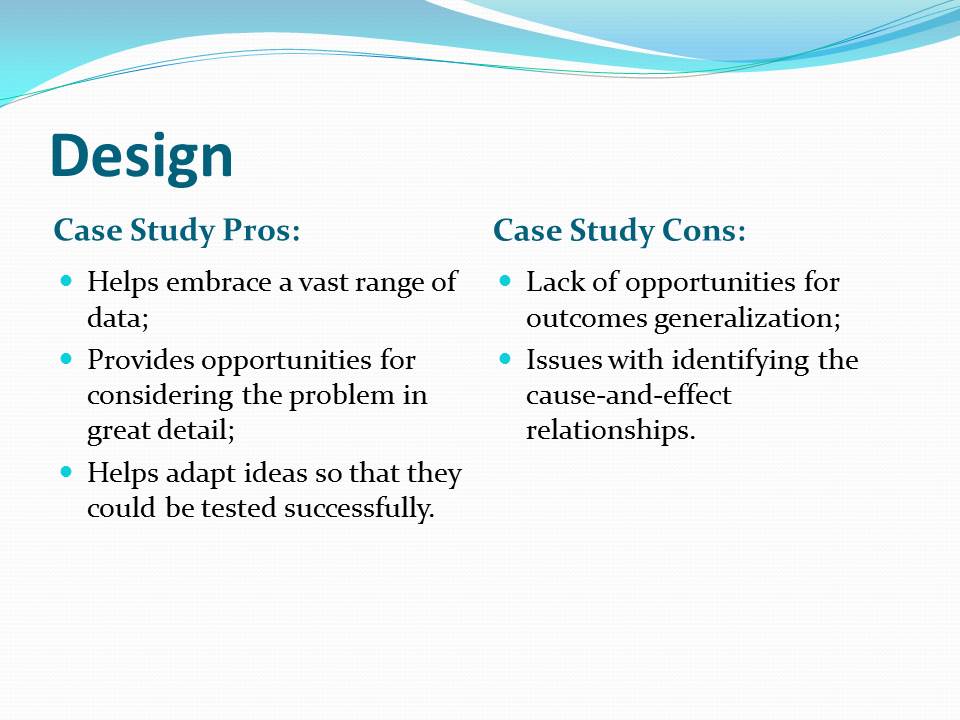
Instruments: Testing Tools
- The patients will be measured twice in the course of the intervention;
- The first measurement will be conducted prior to the intervention;
- The second measurement will be conducted after the intervention;
- Afterward, the measurement results will be compared to detect the changes in the participants’ skills acquisition rate;
- The measurement process will be carried out with the help of the CORE-LD standards.
To evaluate the changes that the intervention will supposedly have on the participants, one will have to consider the use of an appropriate measurement tool. Particularly, it will be necessary to identify the degree, to which each of the participants is affected by their LD. After the therapy is over, the PLDs will be tested once again to identify the changes in their skills, if any. In order to conduct the measurement process appropriately, one will have to consider using the CORE-LD test as the primary tool. The outcomes of the measurement will be quantified so that the information could be used in the subsequent t-test.
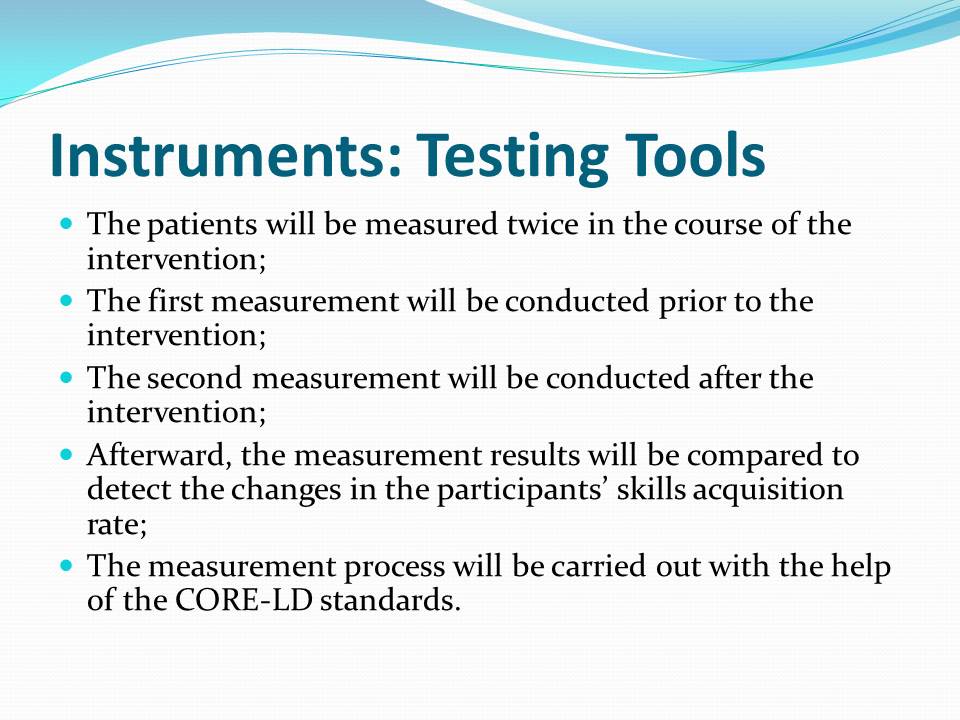
Instruments: Testing Tools (Continuation: CORE-LD)
- The CORE-LD test was designed with the help of PLDs;
- The test focuses on the respondents’ emotional wellbeing;
- The test addresses the most common problems that PLDs are likely to face when undergoing a learning process.
The CORE-LD test can be viewed as the primary means of assessing the degree, to which the patient is affected by their disability, as well as the severity of the obstacle that prevents them from acquiring the corresponding learning skills in a manner as efficient and expeditious as possible in their condition.
Designed with the help of PLDs, the test allows for a rather accurate identification of the presence of an LD issue in a patient. Therefore, it can be viewed as sufficient for providing the basis for the assessment design.
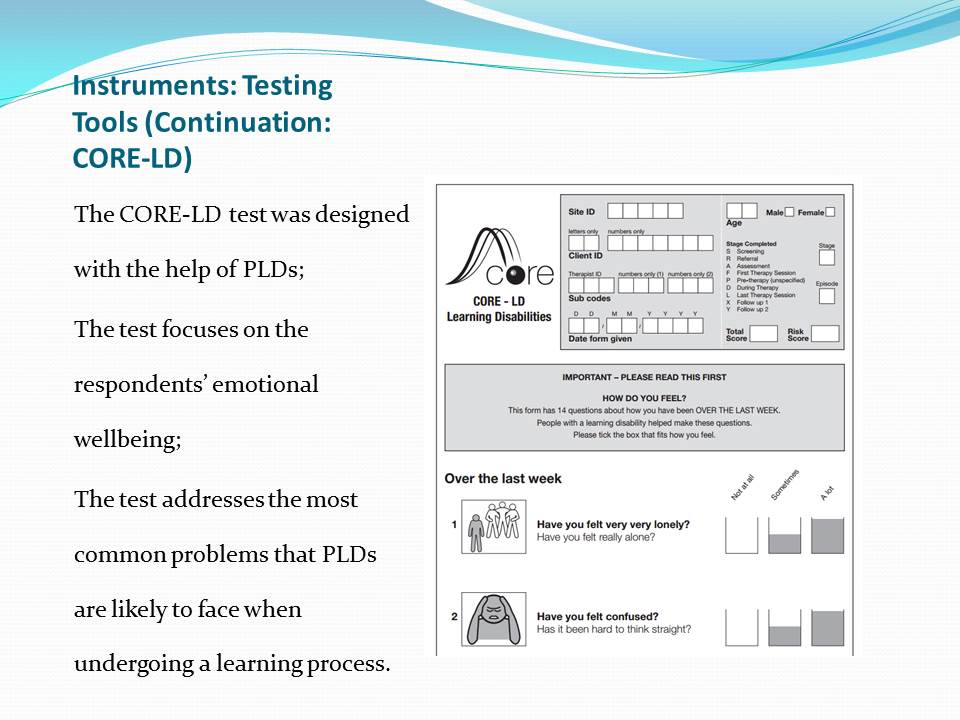
Intervention Description: Phase One
- Communication with the target audience;
- PLDs assessment and detection of the rates of LD in the target population;
- Reinforcement of the talent-oriented approach as the key nursing strategy;
- Focus on allowing the participants to develop unique abilities and talents located in the course of the intervention.
The first part of the intervention will imply carrying out conversations between the nurses and the PLDs selected for the participation in the case study. The PLDs will be assessed based on the CORE-LD-oriented tool. Furthermore, the unique abilities of the participants will be detected. It will be necessary to make sure that PLDs are aware of their capabilities and are willing to explore new opportunities in learning.
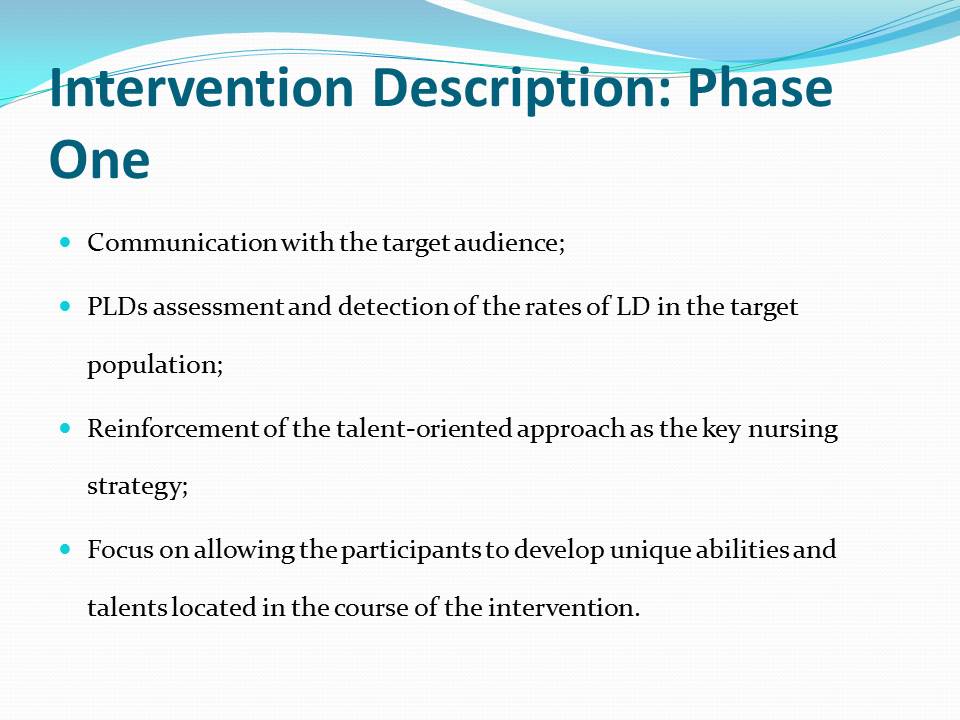
Intervention Description: Phase Two, Part One
- Communication with PLDs;
- Description of the key procedures;
- Provision of the necessary consultations and clarifications;
- Description of the tools for assistance;
- Enhancement of motivation rates among the participants.
The second stage will involve inviting PLDs to participate in online communication in tee environment of the crossed network mentioned earlier. The stage will be split into two key parts. First, the people included in the case study will be provided with instructions on how to operate in the identified network. Furthermore, the PLD members will receive information about the use of the devices that will assist them in the communication process, such as the OCR software, etc. Finally, the patients included in the research process will be offered extensive support from the nurses. Particularly, the information regarding the means of accessing nurses and using their assistance will be delivered to the target audience.
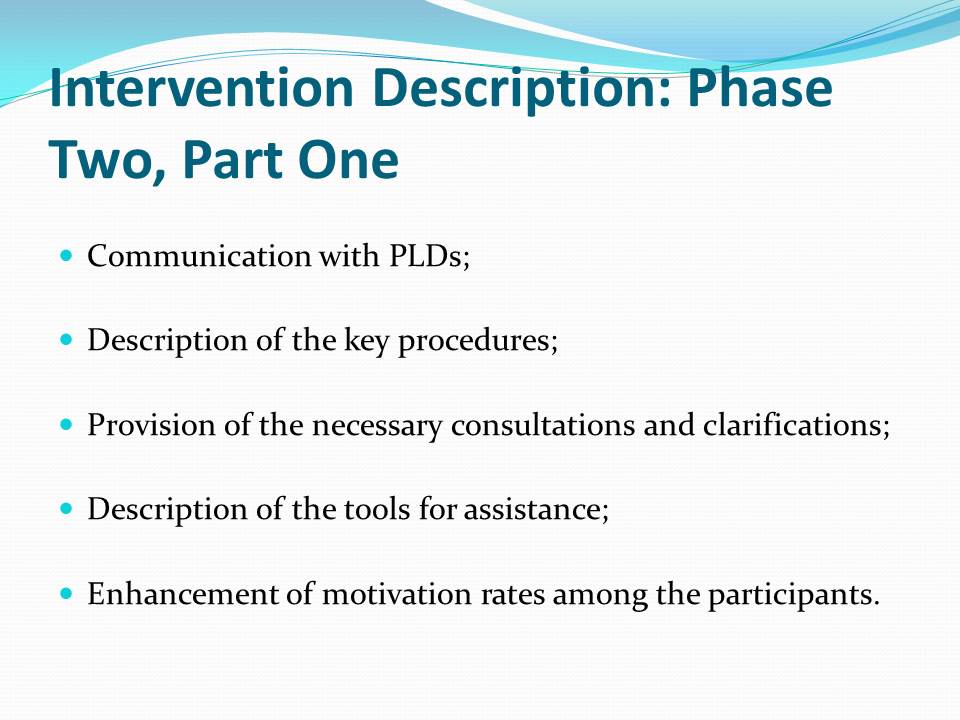
Intervention Description: Phase Two, Part Two
- Introducing the patients to the forums;
- Allowing PLDs to select the area that interests them most and where they can focus on developing their talents and unique abilities in the most efficient manner;
- Monitoring the communication process;
- Assisting the PLDs in case the nurses’ support is needed;
- Providing PLDs with relevant information about the aids that they can use in the process;
- Determining the progress that the participants make (i.e., collecting the core statistical data concerning the communication and learning-related issues faced by the people involved).
The second stage will involve the intervention itself. The patients will be able to choose a specific forum to enter. The forums will require that the participants should join a conversation on a certain topic (e.g., sharing opinions about a recent movie and the emotions that it evoked, etc.). Although group discussions will be a possibility, each of the participants will be assigned with an opponent (a volunteer member of the community) to discuss the subject matter with.
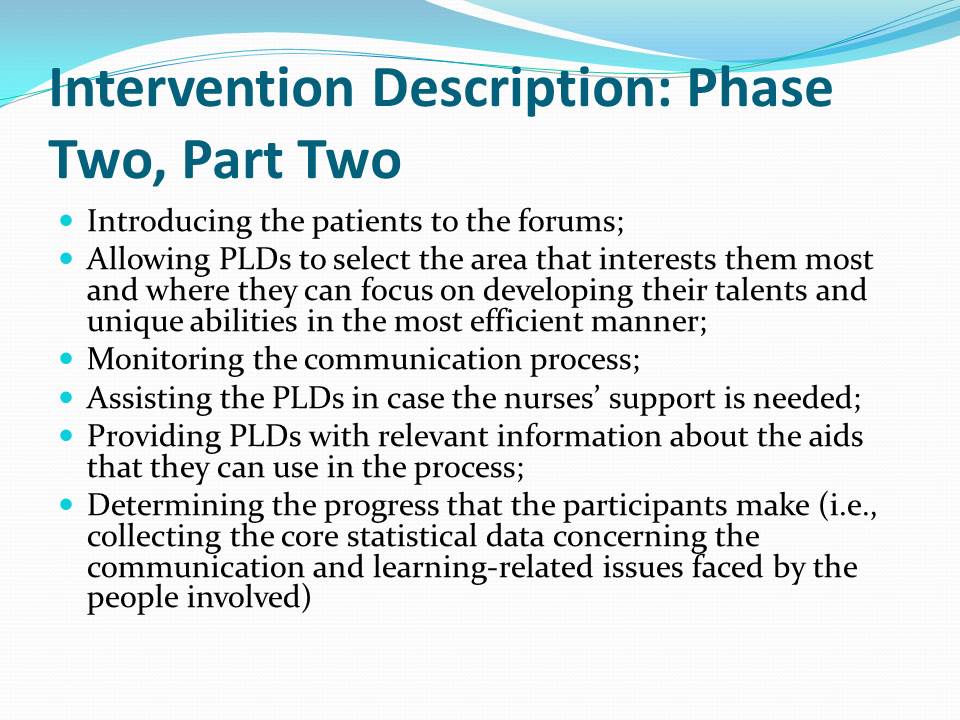
Intervention Description: Phase Three
- Ceasing the communication process;
- Acknowledging the PLDs’ participation and expressing appreciation for their involvement so that they could be empowered to engage in similar experiences on their own.
The conversation logs will be recorded and stored in the online databases so that the researcher could have instant access to it. After the communication process is over, the statistical information concerning the activity rate of the PLD participants, the number of errors related to their LDs made in the process of communication, etc. will be calculated carefully. After the necessary data is collected, it will undergo a statistical analysis. Particularly, Student’s t-test will be used to measure the changes in the PLDs’ progress.
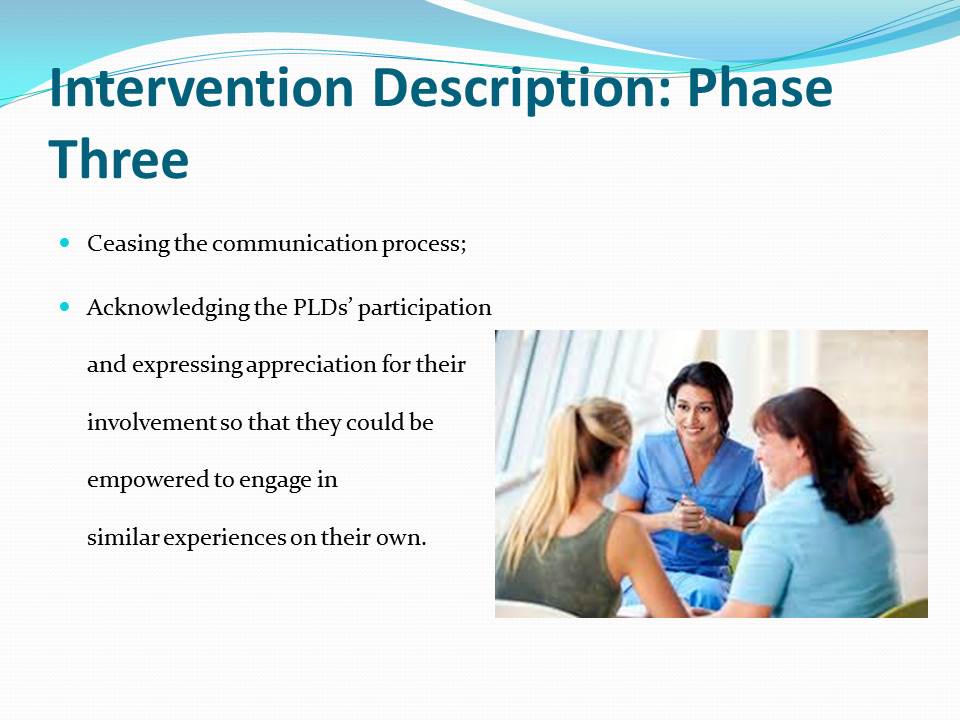
Data Collection Procedures: Part I
- Gathering relevant information from the logs of communication between the participants of the network;
- Quantifying the information so that it could be used for the analysis purposes.
In order to retrieve the information necessary for the further statistical analysis, one will have to determine the performance of the participants. Particularly, the number of mistakes that they make when conversing online will have to be made. As a result, the tendency for either the improvement in the performance of the participants or the gradual drop in their communication abilities can be identified.
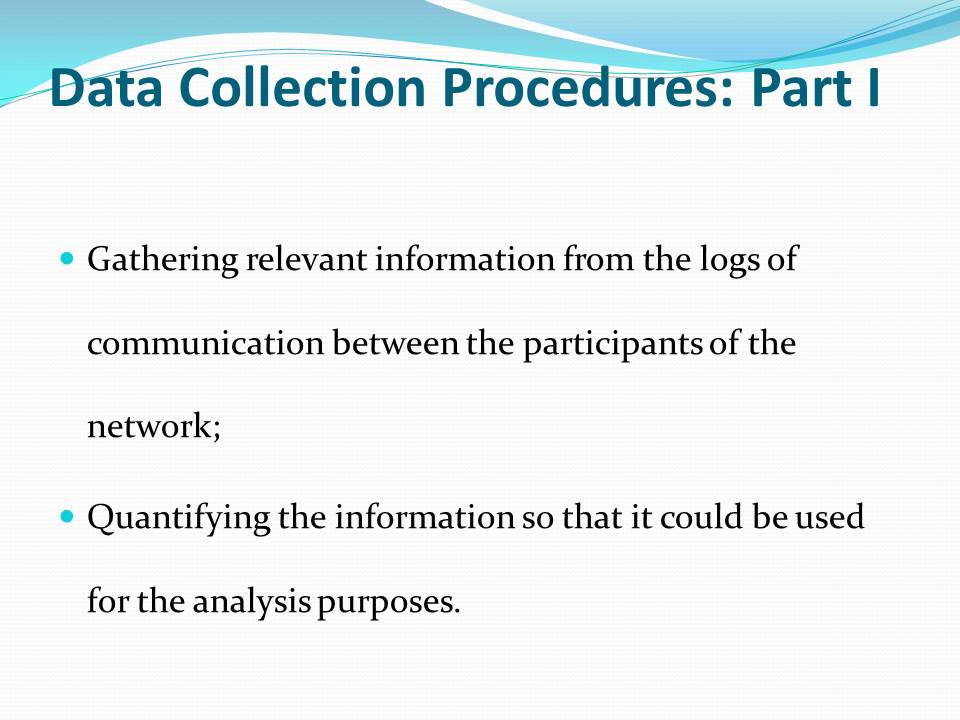
Data Collection Procedures: Part II
- Providing the participants with the CORE-LD tests for the further assessment of their image as learners;
- Retrieving the Forms filled in by the participants (manually);
- Locating the relevant data and quantifying it for the further analysis.
Apart from the information concerning the PLDs’ performance, the data about their perception of their image as learners will have to be analyzed. For this purpose, the use of the CORE-LD tests will have to be considered. The identified framework will create prerequisites for the evaluation of PLDs’ image of themselves as learners.
The identified stage is crucial to the overall progress of the participants since it will help determine the motivation rates among the participants. As stressed above, it is necessary to make sure that the participants should be able to receive a powerful impetus for the further progress and be able to receive information and train skills successfully in the future. Therefore their overall motivation rates as the key criterion for the opportunities of further learning will have to be assessed. For these purposes, the CORE-LD tool will have to be utilized.
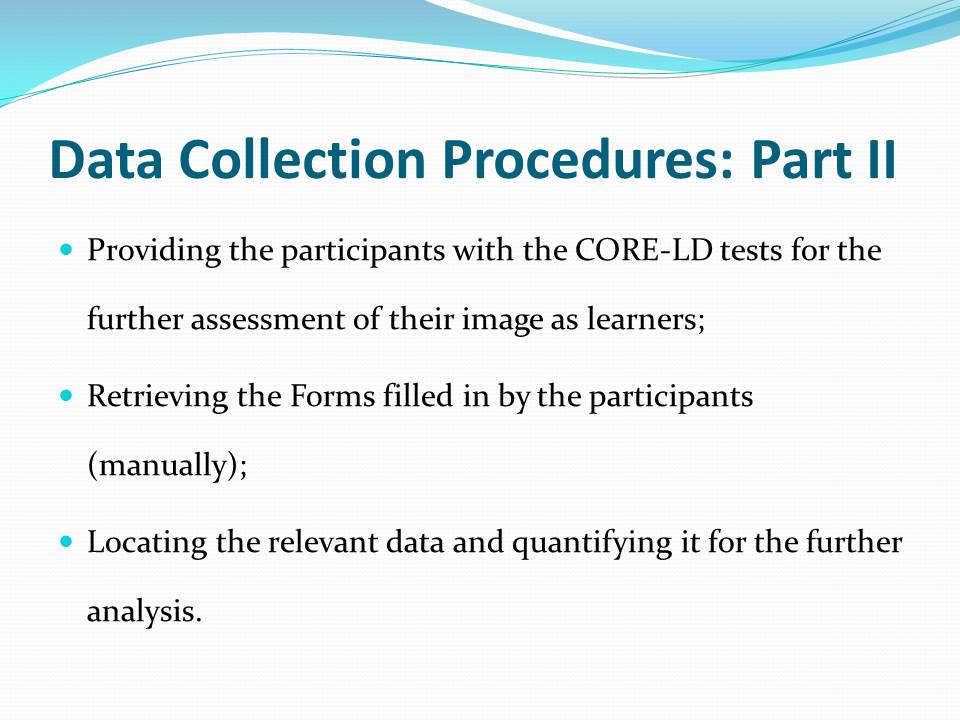
Data Analysis Plans
- Student’s one-sample t-test as the essential device for a statistical analysis will be used;
- The differences between the pre- and post-intervention results delivered by the patients will be considered;
- Student’s one-sample t-test will be used as the essential method of retrieving the necessary information.
The use of Student’s one-sample t-test should be considered as the primary means of determining the efficacy of the intervention. By definition, the specified framework is supposed to measure the differences between two groups of data. In the case in point, the first group will be represented by the scores of the PLDs before the intervention, whereas the second one will incorporate the results delivered by the participants after the essential procedures are carried out and the PLDs involved in the study have supposedly gained the necessary skills and information.
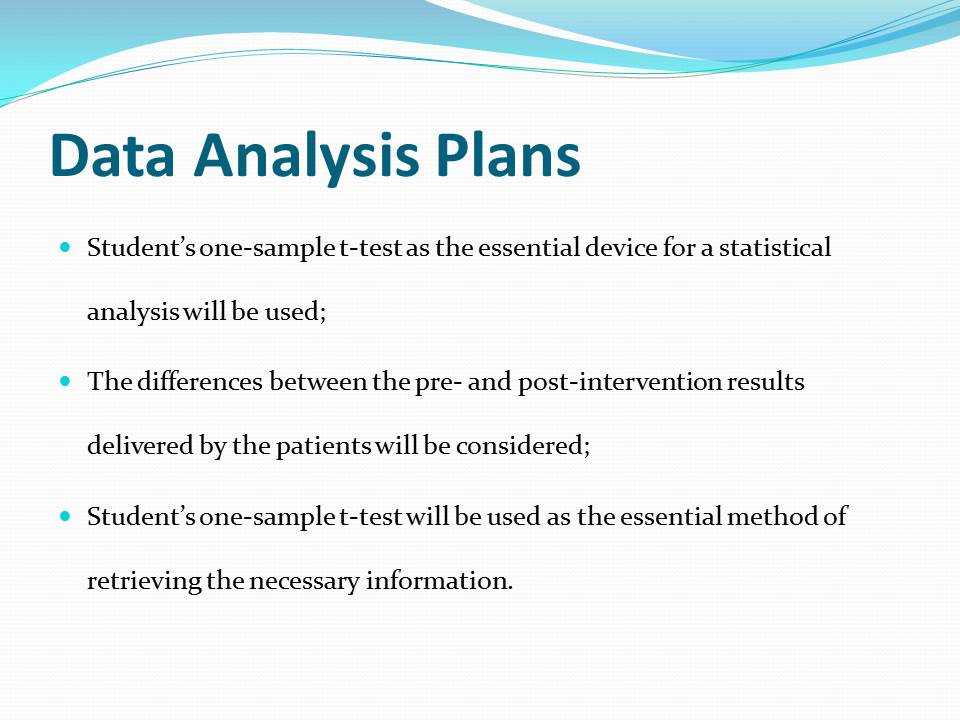
Ethical Issues
- Informed consent forms must be sent to the PLDs’ guardians;
- Personal data of the participants must be stored in password-protected databases;
- IT awareness rates of the researcher must be increased by consulting the relevant resources.
It should be noted that the process may involve dealing with ethical issues. First and most obvious, the fact that the procedure will involve the participation of people with disabilities needs to be brought up. Because of their condition, it will be necessary to make sure that their legal guardians should sign the forms with informed consent; otherwise, the PLDs selected for the case study will not be able to engage in the study.
Additionally, it will be crucial to make sure that the information about the people taking part in research should be fully protected. Personal data disclosure is not to be allowed in the identified setting. Therefore, the use of the corresponding tools that will enhance the security of the information will have to be incorporated. Particularly, specific software and password-protected databases will have to be created. Furthermore, it will be necessary to improve the researcher’s awareness of data protection by reviewing the current concepts of information security.
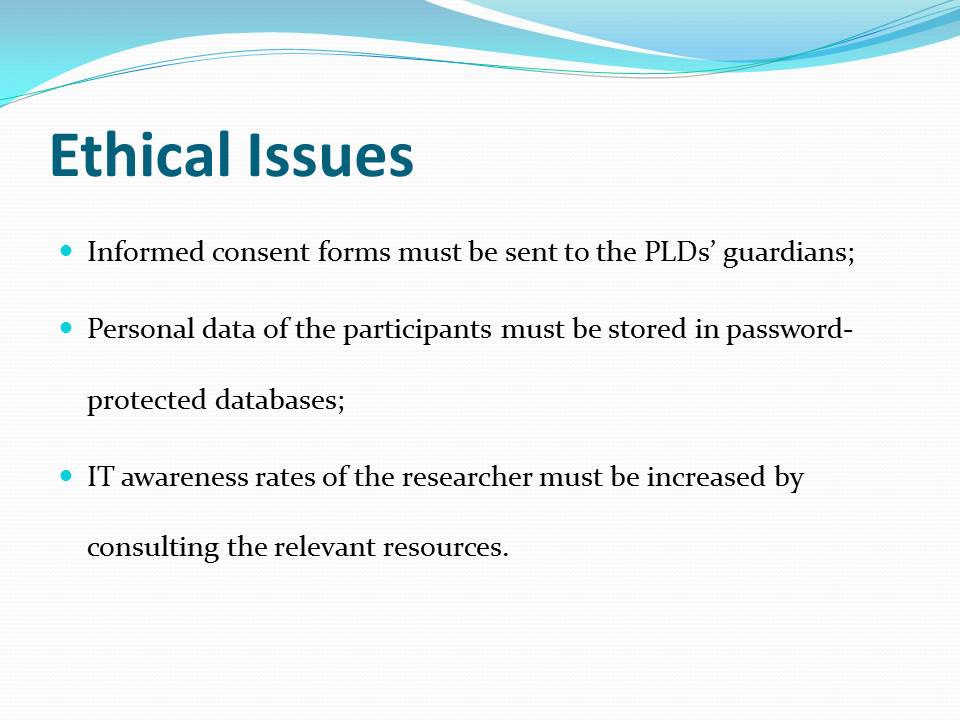
Limitations
Generalizability
Problems with the generalizability of the test results can be viewed as the primary limitation of the study. The applicability may be questioned.
Level of Significance
The level of significance will have to be assigned by the researcher. As a result, the credibility of the paper and research outcomes will suffer to a considerable extent.
The paper has its limitations, most of which are attributed to the fact that a case study was chosen as the research design. The overall tendency of the t-test results to be extraordinarily generalizable is the key reason for concern. In other words, the generalizability of results as the major feature of a one-sample t-test is the key limitation of the study. Furthermore, the fact that the level of significance is assigned to the text by the researcher means that the results of the assessment will have to be considered with a grain of salt.
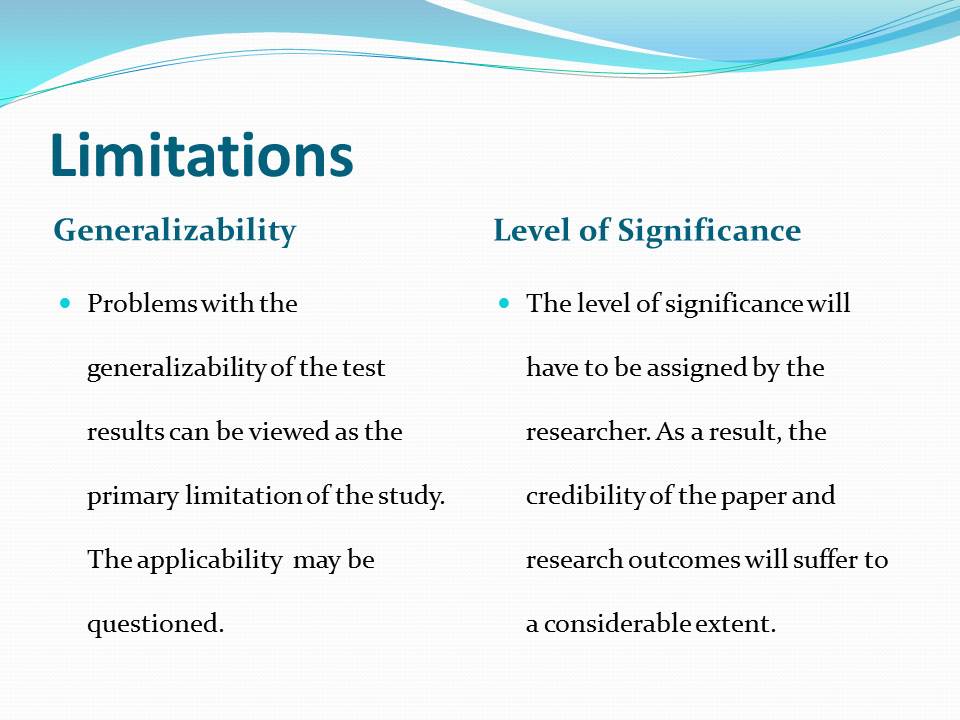
Implications
- Improvement of the current nursing strategies;
- A follow-up study aimed at locating pros and cons of the talent-oriented framework;
- Design of a comprehensive strategy for meeting the needs of all types of PLDs.
The study results are bound to have an effect on the present-day nursing strategies that are used to address the needs of PLDs. Moreover, the outcomes of the study may serve as the prerequisites for a follow-up study that will explore the chances for an all-embracive framework that will shed light on the limitations of the suggested approach, its practical implications for a larger number of patients, and the means if improving the framework so that it could work with other types of developmental disorders.

Conclusion
- The current PLD needs management approach lacks a patient-centered design;
- A poor understanding of the abilities that a PLD may have is likely to lead to a loss of significant developmental opportunities;
- The learning process of PLDs can be enhanced by using crossed network communication and a talent-oriented approach.
The issue of LD is getting increasingly topical for nurses in the contemporary environment. Despite the fact that there are a plethora of tools that are used to meet the needs of PLDs, most of these devices seem to have the same problem. Particularly, they do not allow assuming that PLDs may have unique abilities and event talents that can be used to promote a more successful and a much faster process of the necessary skills acquisition. Furthermore, the use of these talents can spark the process of lifelong learning among PLDs. Therefore, it is crucial that the existing alternatives should be considered closely and analyzed for their further incorporation into the set of the nursing strategies. As a result, a comprehensive framework that will help encourage PLDs to acquire the relevant skills and integrate into the society successfully can be designed.
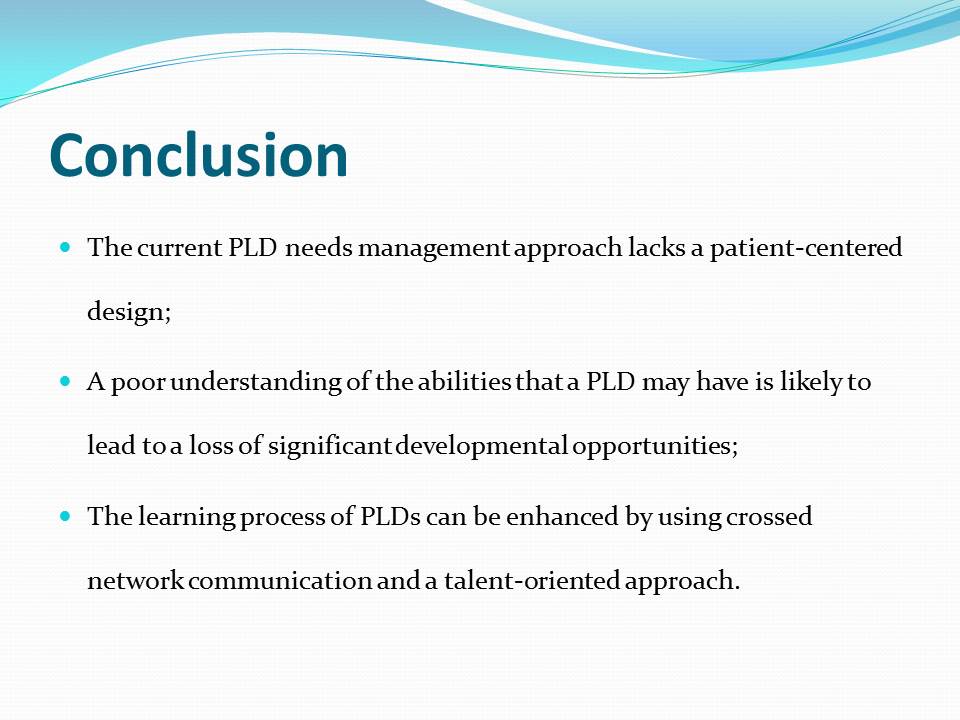
Reference List
Burton, M., Kagan, C., & Clemens, P. (2013). Social skills for people with learning disabilities: A social capability approach. New York, NY: Springer.
Cortiella, C. (2014). The state of learning disabilities. Web.
Logan, J., & Martin, N. (2012). Unusual talent: A study of successful leadership and delegation in entrepreneurs who have dyslexia. Journal of Inclusive Practice in Further and Higher Education, 4(1), 57-76.
Randolph, K. A., & Myers, L. L. (2013). Basic statistics in multivariate analysis. Oxford: OUP.
World Health Organization. (2012). Disability – a global picture. Web.
World Health Organization. (2014). World report on disability. Web.